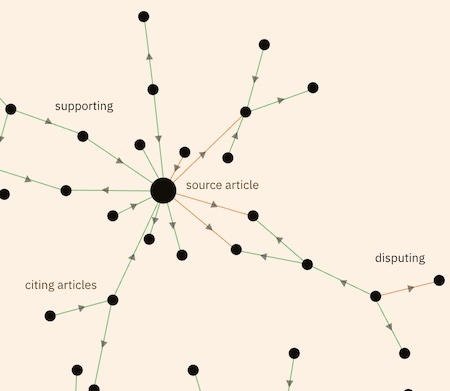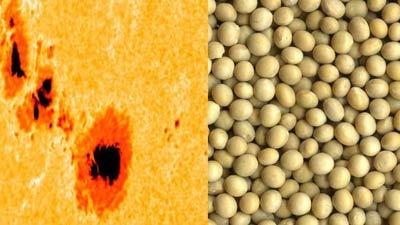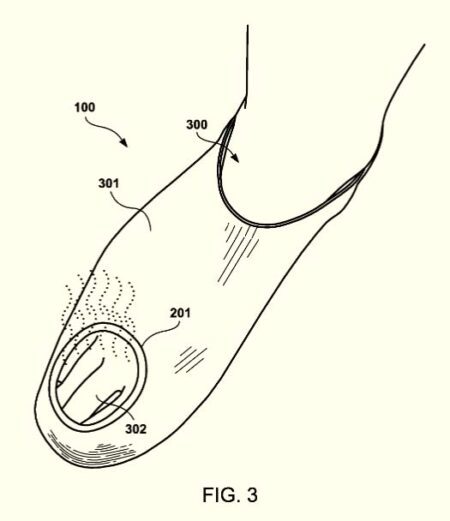Marc Abrahams's Blog, page 85
March 15, 2021
Disagreement theory, sunspots, and the price of soya beans [study]
Does sunspot activity cause disagreements in the soyabean futures market? According to a Feb. 2021 paper in the journal Economic Modelling, the answer is :
[…] theoretically, the information of sunspots causes disagreement in the soybeans futures market mainly by three channels: gradual information flow, limited attention, and heterogeneous priors.
The new study, from Mr. Hanjie Wang , Jun.-Prof. Dr. Jan-Henning Feil and Prof. Xiaohua Yu Ph.D. at the Georg-August-Universität Göttingen, Germany, examined the implications of ‘Disagreement Theory’ (Hong, Stein, 2007) with regard to soya pricing.
[…] to analyze investors’ behaviors given the complicated information of sunspots. Theoretically, disagreements could change market price trends and volatilities. Disagreement on the information of sunspots would shape investors’ behavior.
The empirical results of the study highlight the effect of sunspots information on the volatility of soybeans future price.
Based on the disagreement theory, the underlying mechanism of this phenomenon is that the disagreements exist on the information of sunspot activity among investors of the soybeans futures market. When the sunspots are in a normal status, the weather would be mild for soybean production, and the disagreement on the effects would be small. When the sunspots activities are in an extreme status, either extremely low or extremely high, the disagreement would be high as well.
See : Disagreement on sunspots and soybeans futures price Economic Modelling, Volume 95, February 2021, Pages 385-393. A full (draft) copy of which may be found here
BONUS:
Today’s Soya Beans Futures and options
Today’s Predicted Sunspot Number and Radio Flux
Research research by Martin Gardiner

March 12, 2021
Evangelical Subculture and Phallically Insecure Masculinity [new study]
What little things do some men get excited about? That’s one of the questions addressed in this new study:
 “Linking Evangelical Subculture and Phallically Insecure Masculinity Using Google Searches for Male Enhancement,” Samuel L. Perry [pictured here] and Andrew L. Whitehead, Journal for the Scientific Study of Religion, epub 2021. The authors, at the University of Oklahoma and Indiana University, explain:
“Linking Evangelical Subculture and Phallically Insecure Masculinity Using Google Searches for Male Enhancement,” Samuel L. Perry [pictured here] and Andrew L. Whitehead, Journal for the Scientific Study of Religion, epub 2021. The authors, at the University of Oklahoma and Indiana University, explain:
we analyze Google Trends data and focus on the prevalence of explicit searches for “male enhancement” terms and phrases, simultaneously indicating (1) the internalization of a subculture that prioritizes essentialist, phallocentric standards of masculinity and (2) a privately felt failure to meet those standards. Even after accounting for a host of state‐level confounds, the preponderance of evangelicals in a state consistently predicts more Google searches for terms and phrases like “male enhancement,” “ExtenZe,” “penis pump,” “penis enlargement,” and others. We theorize that the largely patriarchal―and increasingly embattled and radicalized―evangelical subculture explicitly or implicitly promotes equating masculinity with physical strength and size, leaving men influenced by that subculture (whether evangelical or not) to seek solutions for their privately felt failure to measure up.
The authors note that: “All data for replication are freely available from Google and can be found on www.TheArda.com”
BONUS: Professor Perry discusses some of his other, related research, in this video:
UPDATE (March 12, 2021): Our friends at the Museum of Bad Art reminded us that one of their exhibition paintings may relate to this study. Here is a reproduction of that painting, accompanied by the museum’s official description:

March 10, 2021
How are Ig Nobel Prize-Winning Papers Cited?
The Scite organization analyzed some of what happened to the research papers that won Ig Nobel Prizes. Scite published their analysis (which was led by Mason Hayes) online, in Medium:

How are Ig Nobel Prize-Winning Papers Cited?
…Though most Ig Nobel research remains relatively obscure, some award-winning work has been highly cited and become quite famous — for example, Justin Kruger and David Dunning were awarded an Ig Nobel Prize in Psychology for their finding that incompetent people often overestimate their abilities, a finding later named the Dunning-Kruger Effect.
From the ridiculous to the mundane, the disgusting to the thought-provoking, Ig Nobel Prizes are awarded across many disciplines. For example, the Economics Prize was awarded to Kopczuk and Slemrod (2003) for finding that people attempt to live longer if it can get them a lower estate tax upon their death; and the Anatomy Prize to James Heathcote for his work “Why Do Old Men Have Big Ears?”. The set of prize-winning papers is a collection of some of the most outlandish yet interesting research that has been done over the past few decades.
For such a curious set of papers, we at scite were curious to see: other than receiving the Ig Nobel Prize, how have such scientific papers been discussed in the literature? Are they highly cited? Have their findings been supported by others, or disputed? We set out to answer some of these questions using scite’s Custom Dashboards….

March 9, 2021
Beware of Tiny Pseudofossils
A new study warns that teeny tiny fossils may, in many cases, turn out to be only pseudofossils—shaped like the remains of dead critters, but really just lumps of stuff that happen to have those shapes.
[image error]This warning echoes the lesson people draw from the Ig Nobel Prize-winning work of Chonosuke Okamura, who published extensive reports about what he called “mini-species”—mini-dinosaurs, mini-princesses, and much more.
The new paper is: “Organic Biomorphs May Be Better Preserved than Microorganisms in Early Earth Sediments,” Christine Nims, Julia Lafond, Julien Alleon, Alexis S. Templeton, and Julie Cosmidis, Geology, epub 2021. The authors, at Pennsylvania State University, the University of Colorado, and Université de Lausanne, Switzerland, explain:
Organic biomorphs that form via the abiogenic reaction of sulfide with organics are likely to be preserved as pseudofossils in cherts through rapid silica encrustation and, possibly, organic-matter sulfurization. In addition to their striking morphological resemblance to putative Precambrian microfossils, these pseudofossils would share chemical characteristics with actual fossil bacteria, such as complex organic compositions and presence of nitrogen atoms. Importantly, organic biomorphs demonstrate better morphological preservation compared with microbial cells during silicification.
While these findings do not refute previous interpretations of Precambrian putative microfossils, our results call for a circumspect approach when evaluating the biogenicity of chert-hosted organic microstructures.
Carolyn Gramling wrote a report, called “Many Early Fossils May Be Imposters“, about that report, in the February 27, 2021 issue of Science News.
Okamura and the Mini PeopleThe 1996 Ig Nobel Prize for biodiversity was awarded to Chonosuke Okamura of the Okamura Fossil Laboratory in Nagoya, Japan, for discovering the fossils of dinosaurs, horses, dragons, princesses, and more than 1000 other extinct “mini-species,” each of which is less than 1/100 of an inch in length.
Okamura documented his discoveries in a series of books called “Reports of the Okamura Fossil Laboratory,” published by the Okamura Fossil Laboratory in Nagoya, Japan during the 1970’s and 1980’s.

March 8, 2021
Hole ‘Apparatus for dissipating sock heat and moisture’ [new patent]
“Users of shoe apparel (e.g., shoes, sneakers, etc.) often place socks on their feet before positioning their feet into the shoe apparel; such placement is advantageous for a number of reasons. First, a sock may prevent friction between the skin of a user’s feet and the inside of the shoe apparel, thereby alleviating, or minimizing, the possibility of skin abrasions. Second, the sock may provide extra comfort to the user.
[…]
Yet, with the aforementioned advantages come various disadvantages. For example, users of shoe apparel for athletic activities (e.g., running) often experience moisture build-up within the sock; such moisture build-up may lead to skin irritation, discomfort, etc.”
What can be done about an unwelcome in-sock moisture-build-up scenario? US inventor Lukasz Przybylo has just been awarded a US patent, which, in its simplest form, might be described as a sock with a hole in it.
The full subtleties of which may be appreciated by examining : Apparatus for dissipating sock heat and moisture , United States Patent 10,925,324 February 23, 2021
Research research by Martin Gardiner

March 7, 2021
Podcast Episode #1058: “How Kids Learn to Say ‘Trick or Treat’”
In Podcast Episode #1058, Marc Abrahams and psycholinguist Jean Berko Gleason dip into one of JBJ’s famous studies—this one about how young children learn to say “Trick or Treat!”.
Remember, our Patreon donors, on most levels, get access to each podcast episode before it is made public.
Jean Berko Gleason encounters:
“The Acquisition of Routines in Child Language,” Jean Berko Gleason and Sandra Weintraub, Language in Society, vol. 5, no. 2, August 1976, pp. 129-36.
Seth Gliksman, Production Assistant
Available on Spotify, Apple Podcasts, Overcast, Google Podcasts, AntennaPod, BeyondPod and elsewhere!

March 4, 2021
The Spiral Stair or Vice in Medieval Stone Castles
Steps have been taken to better, more straightforwardly, understand the stair or vice. Read all about it, in:
“The Spiral Stair or Vice: Its Origins, Role and Meaning in Medieval Stone Castles,” Charles Ryder, doctoral thesis, University of Liverpool, 2014.

Ryder writes: “This thesis addresses a neglected area of castles studies – the spiral stair. It studies the origins, evolution, placing, structure, role, significance and meaning of spiral stairs in medieval stone castles between 1066 and 1500, so covering the rise, zenith and decline of the castle in England and Wales. Although focussed upon England and Wales, it has a wider geographical spread across Ireland, Scotland, Europe, the Middle East and Japan with particular regard to castles and on even wider when searching for the origins of the spiral stair, encompassing the whole globe.”

March 3, 2021
Lemmy Del Cid joins the Luxuriant Flowing Hair Club for Social Scientists
Lemmy Del Cid has joined the The Luxuriant Flowing, Former, or Facial Hair Club for Social Scientists (LFFFHCfSS), sibling club of the Luxuriant Flowing Hair Club for Scientists (LFHCfS). He says:
(LFFFHCfSS), sibling club of the Luxuriant Flowing Hair Club for Scientists (LFHCfS). He says:
I knew from the very beginning of my life, when I was a baby, that I wanted to grow my hair out. My father had long, flowing, curly, black hair from the time he was very young and I was always fascinated by it growing up. As I became older, I wanted my hair to be as long as possible because, of course, my idols were rock stars. They were Isaac Newton, Leonardo Da Vinci, Albert Einstein, and many more famous scientists who had long, extravagant hair. These men were champions for science and rebelled against societal norms in their respective times. By the time I reached my freshman year of college, I knew having long hair was more than a symbol of beauty and rebellion, it was a statement of who I am as a person. My hair is a part of my cultural identity that tells a lot about my personality. I’m not just that professor that has long, flowing hair. I am a quirky, goofy, funny, and groovy dude, but I am also very intellectual, analytical and introspective. As I continued to learn about the powers of hair from studying indigenous peoples, I discovered I have ancestral roots of the Mayan people from my father’s side. In the Mayan culture, hair is sacred and promotes self-esteem, self-respect, a sense of belonging, and a healthy sense of pride because hair is an extension of yourself. So moral of the story is don’t cut your hair short or else you’ll lose your powers!
Lemmy Del Cid, M.S., LFFFHCfSS
Anthropology Instructor
Department of Social Sciences
Long Beach City College
Long Beach, California, USA


March 2, 2021
Gently Rocking Fruit Flies to Sleep
Innovation seldom ceases in the global effort to learn better ways to get flies, and perhaps people, to get to sleep.
“Sleep Induction by Mechanosensory Stimulation in Drosophila,” Arzu Ozturk-Colak, Sho Inami, Joseph R. Buchler, Patrick D. McClanahan, Andri Cruz, Christopher Fang-Yen, and Kyunghee Koh, Cell, vol. 33, no. 108462, 2020.

The authors, at Thomas Jefferson University and the University of Pennsylvania, report:
“People tend to fall asleep when gently rocked or vibrated. Experimental studies have shown that rocking promotes sleep in humans and mice. However, the mechanisms underlying the phenomenon are not well understood. A habituation model proposes that habituation, a form of non-associative learning, mediates sleep induction by monotonous stimulation. Here, we show that gentle vibration promotes sleep in Drosophila in part through habituation.”
(Thanks to Mark Benecke for bringing this to our attention.)

March 1, 2021
Podcast Episode #1057: “Fifty Shades, by Gray”
In Podcast Episode #1057, Marc Abrahams shows an unfamiliar research study to physicist Melissa Franklin. Dramatic readings and reactions ensue.
Remember, our Patreon donors, on most levels, get access to each podcast episode before it is made public.
Melissa Franklin encounters:
“The Science of Style: In Fashion, Colors Should Match Only Moderately,” Kurt Gray, Peter Schmitt, Nina Strohminger, Karim S. Kassam, PLoS ONE, vol. 9, no. 7, 2014, e102772.
Seth Gliksman, Production Assistant
Available on Spotify, Apple Podcasts, Overcast, Google Podcasts, AntennaPod, BeyondPod and elsewhere!

Marc Abrahams's Blog
- Marc Abrahams's profile
- 14 followers





